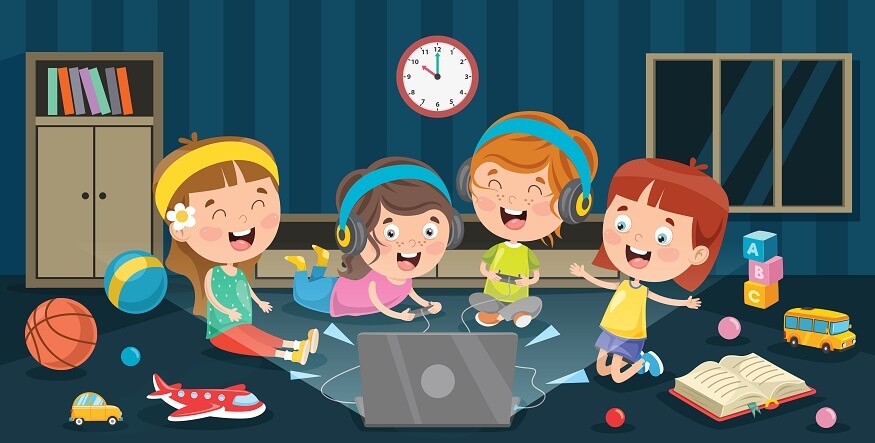The world is going through a digital wave and India seems to be leading the pack. India is projected to have 900 million (90 crores) internet users by 2025 and 1 billion smartphone users by 2026. We are the 2nd largest population on the internet and number one in the world in terms of per capita data consumption. Indians consume more internet data than the US and China put together. While all of this might come as good news in terms of our economic and industrial development. It has its adverse effects.
Internet and smartphone addiction is a real thing. While this addiction is afflicting Indians across age groups, children are especially susceptible to incurring maximum damage. Exposure to screens in terms of television, smartphones, video consoles, and tablets starts early for children. As per reports, even 12-month-olds are spending almost an hour every day staring at screens. As they grow up this screen time goes beyond 2 hours per day. One wonders then, what is the average screen time for a teenager. As per an American study, an average teen spends more than 7 hours staring at screens every day. This is roughly 40% of their waking day. This time is spent typically watching television, online videos, mobile games, reading, video games, social media, etc.
The average screen time for children has increased steadily over the years. This phenomenon can be attributed to various reasons such as accessibility, the hectic schedule of parents in nuclear families, peer pressure, etc.
Screen time affects the development of the brain. This can be especially damaging during the early growth stages of children. Children who are exposed to long screen times have shown diminished language and expressive skills. If you are wondering what should be the maximum screen time for children of different age groups, here are some pointers. Expert paediatrics organisations such as the Irish Association of Speech & Language Therapists and the American Association of Paediatrics have prescribed certain guidelines regarding screen time for children:
- For children under 18 months: Avoid screen time as much as possible, except maybe for video chatting with their friends or relatives.
- For children between 18 to 24 months: Avoid, if possible, but not more than half an hour of screen time per day under adult supervision.
- For children between 3 to 5 years: Not more than an hour of screen time per day.
- For children over the age of 6: Not more than 2 hours of screen time daily.
The question is how to administer these expert recommendations. Taking away a smartphone from a hooked-on teenager can be an uphill task.
Here are some tips that can help parents to reduce screen time for their children.
Awareness of the harms
Most children and parents are not aware of the harms of elongated screen time. The first step is to create awareness about why high screen time is bad. Some of the negative consequences of long screen time are:
– Strain to eyes and body. Long exposure to harmful rays emanating from screens can cause irreparable damage to the eyes. Additionally, most screen time is spent sitting or in suboptimal body postures which takes its toll on the body as well. Symptoms are watery eyes, back pain, shoulder pain, etc.
– Sleep deprivation. The inability to let go of the smartphone even late at night leads to sleep deprivation. The constant scrolling puts our brains off their regular sleep patterns which can have serious side effects.
– Increased obesity risk. Longer screen time implies longer sedentary hours without any physical movements or exercises. Most times it’s also clubbed with consuming junk food. This increases the risk of obesity in children.
– Susceptibility to chronic lifestyle diseases. Sedentary screen time and junk food consumption increase the child’s susceptibility towards lifestyle diseases such as diabetes, heart issues, blood pressure, etc.
If the children and parents are aware of these downsides, it might motivate them to work towards reducing their screen time.
Keep track of screen time
Measurement is the first big step to solving any problem. Most of us do not realise that we are spending an obnoxious amount of time staring at screens. All smartphones have a feature which measures screen time. This could be one source to measure smartphone screen time. Add to this the average time spent watching television, playing video games, etc. and you have the total time spent by your child staring at screens. Find ways of measuring and tracking this screen time. Share the screen time with your child so that they are also able to track it. Set targets for reduction and track the achievement of those targets. To further motivate the children, attach some kinds of rewards contingent on the achievement of the pre-decided screen time reduction targets. This gamification of the efforts to reduce screen time can be engaging for the children and might deliver positive outcomes.
Set ground rules
Parents and schools can set ground rules about the usage of gadgets that lead to screen time. Teenagers can be told that they cannot exceed 2 hours of screen time per day. Additional rules such as if smartphones have to be used then they need to be used while walking, no smartphones on the bed or couch, etc could be good ways to inculcate some healthy habits along the way.
Reduce accessibility
Handing over a smartphone or an iPad to a cranky child has become a norm in most nuclear families today. This must be avoided. Accessibility of children to devices must be limited as much as possible. Children carrying smartphones to school is another phenomenon which is on the rise. Understandably, most parents worry about their children’s safety and thus buy them a mobile phone. That along with the immense peer pressure that children face when all their other classmates have smartphones can be an uphill task to surmount. This is where even the schools have a role to play. At EuroSchool we have strict policies to limit the use of smartphones by our students during school hours. If it is meant for safety then it should be used as such, and not for browsing.
Indulge in other activities
Introduce children to other interesting activities such as sports, music, art and craft, etc. Expose them to hobbies of different kinds to see if something piques their interest. Once they realise how much more fun these physical activities can be, they will feel less pulled towards the world inside the tiny screens.
At EuroSchool we are mindful of the harmful side effects of long screen time. While at school, we take all necessary measures to limit the screen time of children within healthy limits. We also create awareness and healthy habits among our students to motivate them to engage in healthy habits away from the screens.










